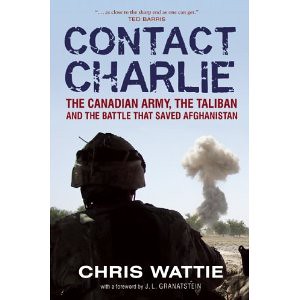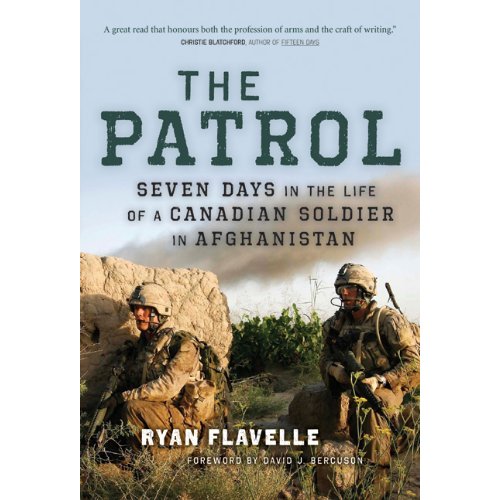 Contact Charlie; the Canadian Army, the Taliban and the battle that saved Afghanistan by Chris Wattie (Key Porter Books Ltd. 2008). This book covers the actions undertaken by Task Force Orion (built around 1st bn Princess Patricia's Canadian Light Infantry) in 2006. The title might seem a bit hyperbolic, but it comes from the regional commander's own assessment of the strategic worth of the operation. What started out as counterinsurgency patrols around Kandahar and in the Panjwayi district of southern Afghanistan turned into the biggest fighting Canadian soldiers had found themselves in since Korea as the men and women of TF Orion uncovered and disrupted a major Taliban buildup in the Panjwayi. This build up was aimed at attacking and occupying Kandahar City to get international press and break the political will of NATO and their voters at home, much the same as the Tet Offensive had done during the Vietnam War many years ago.
Contact Charlie; the Canadian Army, the Taliban and the battle that saved Afghanistan by Chris Wattie (Key Porter Books Ltd. 2008). This book covers the actions undertaken by Task Force Orion (built around 1st bn Princess Patricia's Canadian Light Infantry) in 2006. The title might seem a bit hyperbolic, but it comes from the regional commander's own assessment of the strategic worth of the operation. What started out as counterinsurgency patrols around Kandahar and in the Panjwayi district of southern Afghanistan turned into the biggest fighting Canadian soldiers had found themselves in since Korea as the men and women of TF Orion uncovered and disrupted a major Taliban buildup in the Panjwayi. This build up was aimed at attacking and occupying Kandahar City to get international press and break the political will of NATO and their voters at home, much the same as the Tet Offensive had done during the Vietnam War many years ago. The book is quite good and reads like the Mark Zuehlke books about WW2 that I like so much; deftly moving from the overarching strategic situation and the decisions made by Generals and Colonels to a squad leader wondering what's around the next mud brick corner or a rifleman firing his C7 in a grape field. The actions at Bayanzi (in which Capt. Nichola Goddard's FOO LAV was struck by an RPG, killing her and causing much hand wringing in the press), Seyyedin, Pashmul and the White Schoolhouse are covered in a lot of detail.
The difficulties of the close terrain of the highly cultivated Panjwayi are well described. Grape drying huts, thick walled and impervious to most fire, are common and provided the Taliban with ready made strong points. The Canadian troops suffered as many heat casualties as wounds from enemy fire and mines. In the attack on the White Schoolhouse, two platoons ended up being just 18 men in a desperate firefight with over 10 times their number of insurgents and unable to call in artillery because the new NATO command wouldn't let them.
Now I find myself wondering how to recreate this on the tabletop.... sigh...
 The Patrol; Seven Days in the Life of a Canadian Soldier in Afghanistan by Ryan Flavelle (Harper Collins Publishers Ltd. 2011). Is an excellent memoir by a young University of Calgary Grad student/reservist signaller who volunteered for an Afghanistan deployment, because as he naively thought; that's what soldiers do.
The Patrol; Seven Days in the Life of a Canadian Soldier in Afghanistan by Ryan Flavelle (Harper Collins Publishers Ltd. 2011). Is an excellent memoir by a young University of Calgary Grad student/reservist signaller who volunteered for an Afghanistan deployment, because as he naively thought; that's what soldiers do. The writing is brilliant and captures these young men and what they are doing amazingly well with a prose that equals G.M. Frasers' Quartered Safe Out Here or Farley Mowat's And No Birds Sang. He describes the feelings of being on a night patrol lyrically and describes his own emotions forcefully. He and his companions joke about using explosives to make their hilltop Forward Operating Base look more like Castle Greyskull from the Masters of the Universe cartoon. I can relate to this nerdy, bespectacled university student feeling not-one-of-the-group in a small tight group of professional infanteers; his concerns with trying to keep up, not be weak and not look like a dork in front of his platoon are what keep him going. The lengthy section in which he describes packing his kit for the 7 day patrol makes illuminating reading; what to bring, what to put in which pouch, how much water he stows in various points around his tacvest and rucksack and how damn heavy it all gets. He attaches his bayonet to the bottom of his ruck, not because he expects to use it, but because: "On the very slim chance that we get ordered to fix bayonets (which has happened on previous tours), I don't want to be the idiot without a pointy gun."
The patrol does encounter some firefights and IED strikes. It is not the most intense action of his tour, but it is the first time under fire for him, and the patrol is for the authour a turning point. He tested himself and realized that he was scared, but not paralyzing scared, just scared in the sense that part of his brain was reminding him that if he had made better life choices he wouldn't be ducking from RPGs and machine gun fire behind a mud wall. He has a lot of interesting meditations on what makes infantrymen different and unique and why they look down on everyone else (especially the rear echelon soldiers, with the exception of the cooks. He praises the cooks a few times for working hard in trying circumstances to keep them fed). The infantry do everything hard and that hard road is what shapes them. Every Canadian soldier is a volunteer and Flavelle observes that when the going gets hard, the Canadian soldier bitches a bit, hitches up his ruck and reminds himself that he volunteered to be there in that hard spot. The choice to not do it was made a long time ago. In some brutally honest self reflection Flavelle also realizes that he is not a warrior and will never excel at, or relish in, combat. But he does take comfort in the fact that for a few months he stood with Canadian warriors and did his job as best he could.
The sections in which he describes the transition back to Canadian life are the most poignant. Even reunited with his girlfriend, his parents and mom's cooking he still misses his platoon and wonders where his rifle is. Walking to the kitchen in the dark in his own home and trying to miss the creaking floorboard like he'd done hundreds of times as a kid and suddenly he is back on night patrol, looking for bootprints in the dust (it is only safe to step where someone else has already stepped), frozen in fear and hoping to not step on an IED.
Both books are highly recommended for anyone interested in the Canadian army, Afghanistan or the experiences of a modern soldier.
The publishers promo blurb on the back dust jacket is by General Hillier. He orders us all "Read this book."
Yes sir!





































































I served with some Canadian solders of the Royal Canadian regiment when I was doing my spot in Afghanistan, in Gazani province in 05/06.
ReplyDeleteThey were all a pretty stand up lot and I enjoyed working with them the few times we did.
Wish I could remember more about them now.
Thank you, James for a really interesting review. It sounds like an excellent book. I'm particularly interested in the part about reintegrating and transitioning into life at home. I'm going to try and get a copy. Thanks again.
ReplyDeleteI'd recommend reading "Retreat from Kabul" next, and then see if the overall experience has changed in the 100 and odd years.... I suspect not. If Alexander's veterans had published any memoirs I bet they wouldn't have been significantly different either!
ReplyDelete